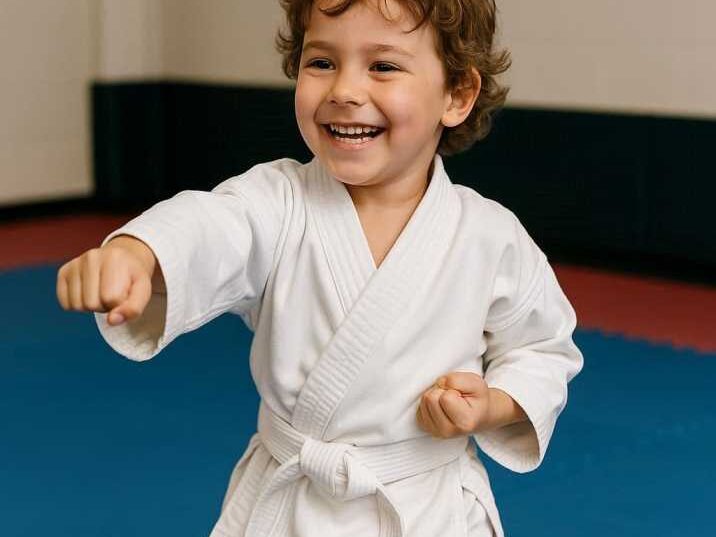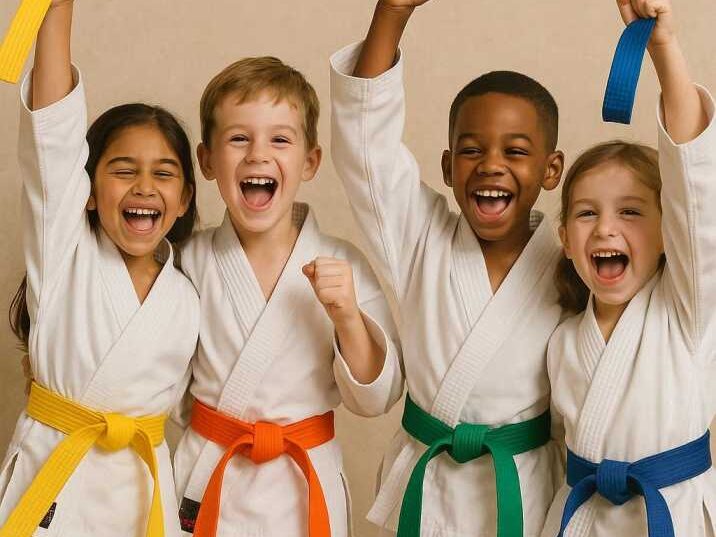Introduction
Table of Contents
Raising kids today isn’t easy. With screens everywhere, busy school schedules, and fewer opportunities for active play, many parents worry about their child’s growth and confidence. That’s where martial arts for child development comes in.
Martial arts are more than just kicks and punches. They’re a way for children to build discipline, focus, respect, and confidence, all while staying active and having fun. Parents often notice positive changes not just in fitness, but also in how their kids behave at home and school.
In this article, we’ll explore the 10 powerful benefits of martial arts for child development, clear up common concerns, and give you practical tips to help your child succeed on (and off) the mat.

What Are Martial Arts for Kids?
Martial arts are systems of self-defense and physical training that combine movement, discipline, and respect. Popular forms for children include:
- Karate – Focuses on discipline, striking, and respect.
- Taekwondo – Known for dynamic kicks and Olympic recognition.
- Judo – Emphasizes throws, balance, and cooperation.
- Brazilian Jiu-Jitsu (BJJ) – Focuses on ground defense and problem-solving.
- Kung Fu – Builds coordination, tradition, and fluid movement.
For kids, martial arts are carefully adapted to be safe, fun, and age-appropriate. Classes often include games, drills, and life lessons to encourage character growth alongside physical skills.
10 Benefits of Martial Arts for Child Development
1. Builds Discipline and Self-Control
One of the most important life skills a child can develop is self-discipline. In martial arts, kids quickly learn that every movement, from a bow to a kick, requires focus and respect. They can’t just do whatever they want—the class structure helps them follow rules in a positive way.
For example, a child who might struggle to sit still in school often learns to listen carefully in martial arts because the environment is both fun and respectful. Parents often notice that after a few weeks of training, their child is more willing to finish homework or follow bedtime routines without constant reminders.
Martial arts also teach kids to manage impulses. Instead of reacting with anger, children practice patience by waiting for their turn, respecting their training partners, and controlling their movements. This skill carries into daily life—helping siblings share toys or teaching kids to pause before acting out when frustrated.
Research backs this up: studies show that kids in structured sports like martial arts have improved attention spans and greater self-regulation skills compared to peers.
👉 Parent Tip: Reinforce this at home by celebrating small acts of self-control, like finishing chores before playtime.
2. Improves Confidence and Self-Esteem
Confidence is built, not given—and martial arts provide plenty of opportunities to build it step by step. Every time a child learns a new technique or earns a belt, they experience success that boosts their self-esteem.
Many parents report that shy or quiet kids become more outgoing after joining martial arts. For example, a child who once hesitated to speak in class may proudly demonstrate their form in front of peers after weeks of training. That courage then spills over into school presentations, social activities, and friendships.
The structured belt system in martial arts is especially powerful for confidence. Kids learn that hard work pays off and that achieving goals requires consistent effort. Unlike some sports where only the most athletic get recognition, martial arts reward personal growth, allowing every child to feel proud of progress.
Confidence in martial arts isn’t about arrogance—it’s about believing in yourself. When a child believes they can master a skill on the mat, they start believing they can also solve problems at school or handle challenges in life.
👉 Parent Tip: Encourage your child to talk about their achievements in class and praise their effort, not just the outcome.
3. Encourages Respect and Kindness
Respect is at the heart of every martial art. From bowing before entering the dojo to addressing instructors politely, children learn that kindness and courtesy are just as important as kicks and punches.
For many parents, this becomes one of the most noticeable changes. A child who once interrupted conversations may start waiting patiently to speak. Kids often carry dojo respect into everyday life—holding doors for others, saying “thank you” more often, or treating teachers with greater consideration.
Martial arts also teach children that true strength comes with humility. They learn to treat training partners gently, ensuring everyone stays safe and supported. This builds empathy, as children realize their actions directly affect others.
Interestingly, instructors often use role-play to teach kindness. For example, kids might practice how to calmly walk away from a playground conflict instead of fighting. Parents often see reduced sibling arguments and better teamwork at home as a result.
👉 Parent Tip: Reinforce dojo lessons by encouraging respectful habits at home, such as greeting family members, helping with chores, or showing gratitude.
4. Strengthens Focus and Concentration
In today’s world of constant distractions, focus is one of the most valuable skills a child can have. Martial arts naturally train children to concentrate. Every stance, move, and sequence requires full attention, teaching kids to block out distractions and stay in the moment.
A common example: children who once struggled to sit still for homework often show noticeable improvement after a few weeks in martial arts. Why? Because they’ve learned how to direct their energy into a single task. Instructors make this fun by turning focus into a game—such as asking kids to follow a sequence of moves without losing rhythm.
This improved concentration carries over to school. Teachers often notice that martial arts students are better at listening, staying on task, and completing assignments.
Research highlights that children engaged in martial arts often display improved cognitive performance and memory retention due to this repeated mental practice.
👉 Parent Tip: At home, encourage your child to use martial arts focus techniques (like deep breathing) before starting homework.
5. Promotes Physical Fitness
With childhood obesity on the rise in the US, keeping kids active is a top priority. Martial arts offer a fun way to exercise while also teaching valuable life lessons.
Classes involve a mix of stretching, cardio, strength training, and agility drills. Kids improve balance, flexibility, coordination, and endurance—all while having fun. Unlike traditional gym workouts, martial arts disguise exercise through exciting activities like kicking pads or sparring with friends.
For example, a child who dislikes running laps in gym class might happily perform 20 kicks in a row without realizing how much energy they’re burning. Over time, martial arts help kids develop strong muscles, better posture, and healthier body weight.
More importantly, martial arts encourage lifelong fitness habits. Kids learn that being active is enjoyable, not a chore. This can set the stage for healthier choices as they grow older.
👉 Parent Tip: Support your child by ensuring they eat a balanced diet and get enough rest to fuel their martial arts training.
6. Teaches Self-Defense and Safety Awareness
One of the biggest draws for parents is that martial arts teach kids to protect themselves. But here’s the key: martial arts emphasize defense, not aggression. Children learn how to stay safe, avoid danger, and respond calmly if threatened.
For example, kids are often taught simple strategies like:
- Keeping a safe distance from strangers.
- Using a strong, confident voice to say “stop.”
- Escaping a grab by using leverage instead of force.
These skills give children confidence without making them aggressive. In fact, kids who know self-defense are less likely to engage in fights because they don’t feel the need to prove themselves.
Self-defense training also boosts awareness. Children learn to pay attention to their surroundings, notice potential dangers, and make smart choices. This is especially valuable in today’s world where safety is a top concern for parents.
👉 Parent Tip: Reinforce these lessons by practicing safety scenarios at home, such as what to do if someone they don’t know approaches them.
7. Reduces Stress and Anxiety
Even kids experience stress—whether from schoolwork, friendships, or daily challenges. Martial arts provide a healthy outlet to release that tension.
The physical activity itself releases endorphins (the brain’s “feel-good” chemicals), which naturally improve mood and reduce stress. Many classes also include breathing exercises and meditation practices that teach children to calm their minds and manage emotions.
Parents often notice their child is calmer and more relaxed after class. For example, a child who had a tough day at school might come home happier after a martial arts session. The structured environment provides consistency and comfort, helping kids feel secure.
In the long run, martial arts give children tools to handle life’s challenges. Learning to stay calm during sparring or when faced with a tough opponent teaches kids how to keep their cool during stressful real-world situations.
👉 Parent Tip: Encourage your child to use deep-breathing techniques from class whenever they feel overwhelmed at home or school.
8. Boosts Social Skills and Friendships
Martial arts classes are built around teamwork and cooperation. Kids train with partners, support each other during drills, and celebrate each other’s progress. This naturally builds social confidence and friendship skills.
For shy kids, martial arts can be a breakthrough. Training in a group environment helps them feel included, and the structured activities make it easier to connect with others. Parents often notice their child making friends more quickly and feeling more confident in group settings.
Social skills learned in martial arts—such as communication, leadership, and empathy—carry over into school and daily life. Children become more comfortable speaking up, helping others, and building healthy relationships.
👉 Parent Tip: Encourage your child to invite a martial arts friend for a playdate. This strengthens bonds outside the dojo and builds long-term friendships.
9. Develops Goal-Setting Habits
One of the most powerful aspects of martial arts is the belt system, which teaches kids how to set and achieve goals.
Each belt represents a milestone. To earn it, kids must practice, stay consistent, and demonstrate improvement. This process helps them understand that success doesn’t happen overnight—it comes from effort and persistence.
For example, a child aiming for their yellow belt may struggle with a certain kick. Instead of giving up, they learn to keep practicing until they succeed. This mindset transfers to schoolwork, hobbies, and even chores at home.
Martial arts also teach children how to handle setbacks. Not passing a belt test the first time becomes a learning opportunity rather than a failure. This resilience helps kids bounce back stronger in all areas of life.
👉 Parent Tip: Celebrate progress, not just results. Remind your child that every step forward—big or small—brings them closer to their goals.
10. Strengthens Family Bonds
Finally, martial arts can bring families closer together. Many schools offer family classes where parents and kids can train side by side. Even when parents don’t participate, attending belt ceremonies or cheering from the sidelines creates shared experiences and lasting memories.
Martial arts also give families new ways to connect at home. Parents and children often practice moves together, discuss lessons learned in class, or set goals as a team.
Parents frequently report that martial arts help reduce family stress. Instead of battling over screen time, families enjoy watching their child grow in confidence, discipline, and skills.
👉 Parent Tip: Join in the fun! Even if you don’t take classes, learn a few moves with your child at home—it shows support and strengthens your bond.
Are There Risks or Concerns for Parents?
Some parents worry that martial arts might be too aggressive or dangerous. The truth is:
- Safety comes first – Classes are supervised by trained instructors.
- No full-contact for beginners – Young kids usually practice controlled movements, not sparring.
- Positive reinforcement – Programs focus on respect, not violence.
- Proper gear – Protective pads and mats reduce the risk of injuries.
Safety Tips for Kids in Martial Arts
- Choose a reputable school with certified instructors.
- Make sure your child wears protective gear when sparring.
- Encourage your child to stretch and warm up before class.
- Check that the class emphasizes respect and safety over competition.
- Keep communication open with instructors about your child’s needs.
Comparison: Martial Arts vs. Other Sports
| Feature | Martial Arts | Team Sports (Soccer, Basketball, etc.) |
|---|---|---|
| Discipline | Strong focus on respect and self-control | Focus on teamwork and competition |
| Fitness | Full-body workout, strength + flexibility | Great cardio and teamwork |
| Individual Growth | Progress at your own pace | Team performance often emphasized |
| Confidence Building | Belt systems reward personal effort | Winning/losing can affect confidence |
Both are valuable, but martial arts offer a unique balance of physical training + life lessons.

Conclusion
Martial arts aren’t just about kicks, punches, or belts. They’re about shaping children into confident, respectful, and resilient individuals. By enrolling your child in martial arts, you’re giving them tools that go far beyond the mat—skills that help at home, school, and throughout life.
If you’re looking for a way to keep your child active, build character, and boost confidence, martial arts might be the perfect solution. Take the first step today—you’ll be amazed at the growth you’ll see in your child.
FAQs
1. At what age can my child start martial arts?
Most schools accept kids as young as 4–5 years old with beginner-friendly programs.
2. Will martial arts make my child aggressive?
No. In fact, martial arts teach respect, patience, and self-control, helping reduce aggressive behavior.
3. How often should kids train in martial arts?
2–3 times per week is ideal for steady progress without burnout.
4. Can martial arts help with my child’s focus in school?
Yes! The mental discipline from martial arts often improves attention span and academic performance.
5. What’s the best martial art for my child?
It depends on your child’s personality. Taekwondo for high energy, BJJ for problem-solving, Karate for discipline, etc.

